|
|
INSIDE THE
PLAYBOOKS |
DAVE SARACHAN, THE
COACH OF THE CHICAGO FIRE AND A FORMER ASSISTANT COACH OF THE U.S. MEN'S NATIONAL TEAM,
SCOUTS SIX PROMINENT SQUADS AND DESCRIBES THE WAYS THEY LIKE TO GO AT THEIR OPPONENTS. |
| THE FINE POINTS |
AS TOLD TO JEFF Z. KLEIN |
|
|
|
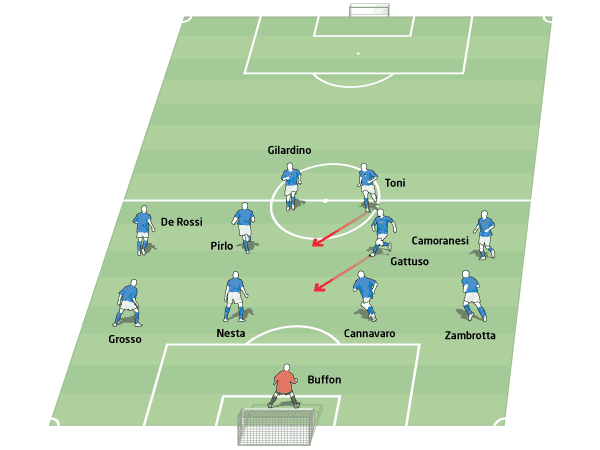 |
|
|
|
|
THE LOCKDOWN |
|
| Italy is extremely organized defensively. They're not as conservative as
they used to be, but in big tournaments they still have a conservative mentality. Skip to
next paragraph World Cup Playbooks Brazil: All-Out Attack Germany: The Free Kick England:
Midfield Power The Netherlands: Wing Play U.S.A.: Going Wide One-on-One The New York Times
Sports Magazine. Go to Complete Coverage » They'll start with four defenders, four
midfielders and two forwards. If they are protecting a lead, they'll drop Gennaro Gattuso,
who's a terrific defensive midfielder, back into a deeper position. They'll drop one of
their forwards back or replace him with another central midfielder. All this will lock out
the middle. To beat a locked-in team like that, you can try to go wide to cross balls into
the box or play long balls from your half and hope your forwards can get to one of them.
Or you can concede territory when the ball turns over, and let them come at you. Then,
when you win the ball back and they're exposed, you can counterattack and maybe catch 'em.
But if you hold on to the ball too much and allow the Italians to get set, they're a very
tough team to crack. They're one of the best in the world at killing off a game. |
|
|
|
| Brazil plays a 4-2-2-2: four defenders, two rows of midfielders and two
forwards. It's an interesting formation, and unique. Skip to next paragraph World Cup
Playbooks Italy: The Lockdown Germany: The Free Kick England: Midfield Power The
Netherlands: Wing Play U.S.A.: Going Wide One-on-One The New York Times Sports Magazine.
Go to Complete Coverage » It works because Brazil has so many tremendous players who can
get forward and also get back to defend. In the midfield, Ronaldinho has the freedom to
find the game wherever he wants — not quite as much as when he plays for Barcelona,
but still, he's free. He likes to drift to the left, and when he does, the midfielder
Kaká will move into a more central role. On the flanks, you've got Cafu and Roberto
Carlos running the entire length of the field and serving balls in toward the goal. And
then you've got big, strong guys in front, like Ronaldo and Adriano, who are not only
gifted with their feet but are good in the air as well. So they attack with three, four,
five guys at once. Two defensive midfielders, Emerson and Zé Roberto, hold down the
center while everyone is going forward. They can destroy you in a million different ways. |
|
|
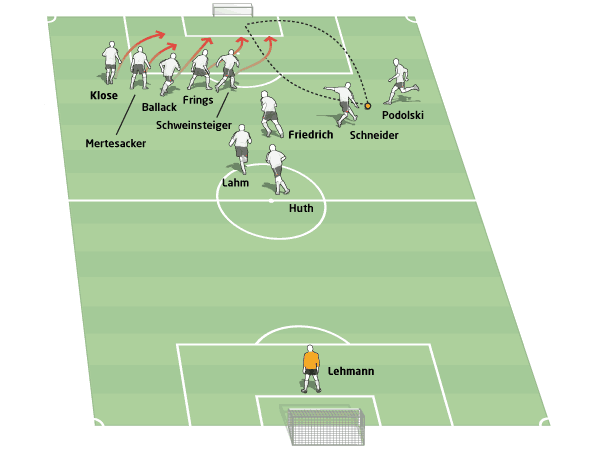 |
|
|
|
|
|
|
| Taking a free kick is not rocket science, but the Germans do it as well
as anyone in the world. Skip to next paragraph World Cup Playbooks Italy: The Lockdown
Brazil: All-Out Attack England: Midfield Power The Netherlands: Wing Play U.S.A.: Going
Wide One-on-One The New York Times Sports Magazine. Go to Complete Coverage » Generally,
they'll put two players over the ball, a left-footer, like Lukas Podolski, and a
right-footer, like Bernd Schneider, to disguise which way the ball will come in. Usually
they'll hit an in-swinger, which curves in toward the goal at high speed and is very
tricky to defend against. Their other players will line up near the goal and then run
toward the net. The first runner and maybe the second will be decoys, and then the third
out of, say, five runners will be Michael Ballack, their best player, who scored on the
United States four years ago on one of these plays. With all this movement in a confined
space, it's easy for the defenders to lose a man. If the ball is hit properly, Ballack
will just get to it first and head it on target. To make this kind of set piece work, you
need movement, good service, guys who are good in the air and courage — to jump into
a crowd of people knowing that a goalkeeper is coming. |
|
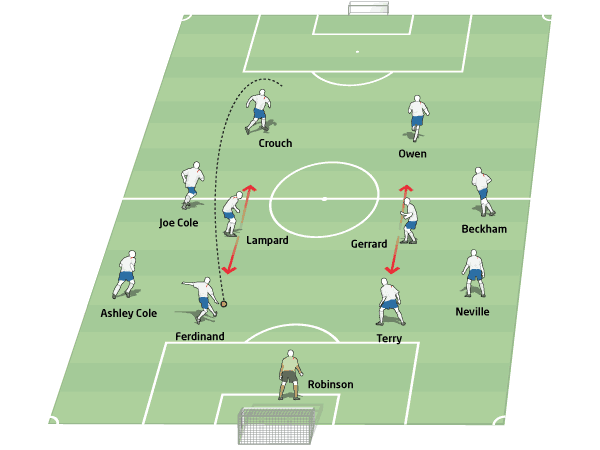 |
|
|
|
|
|
| They depend so much on Wayne Rooney. But if he stays injured, England
will still probably go with the same 4-4-2 formation — only Peter Crouch will be
Michael Owen's partner up front. Skip to next paragraph World Cup Playbooks Italy: The
Lockdown Brazil: All-Out Attack Germany: The Free Kick The Netherlands: Wing Play U.S.A.:
Going Wide One-on-One The New York Times Sports Magazine. Go to Complete Coverage »
Crouch is very tall, very good in the air and much better with his feet than people give
him credit for. So even though losing Rooney is a blow, they now have an option they might
not have had before: to play longer, more direct balls from the back. Otherwise, they can
still build up through the midfield, with Steven Gerrard and Frank Lampard playing side by
side. Since both of them like to come forward, the question there is, can one of them sit
back? But in the end, England is more likely to play longer balls to the front of the
opposing goal. There aren't many in the world who are better at that than David Beckham.
And every one of these guys across the midfield — Beckham, Gerrard, Lampard and Joe
Cole — can shoot very well from distance. |
|
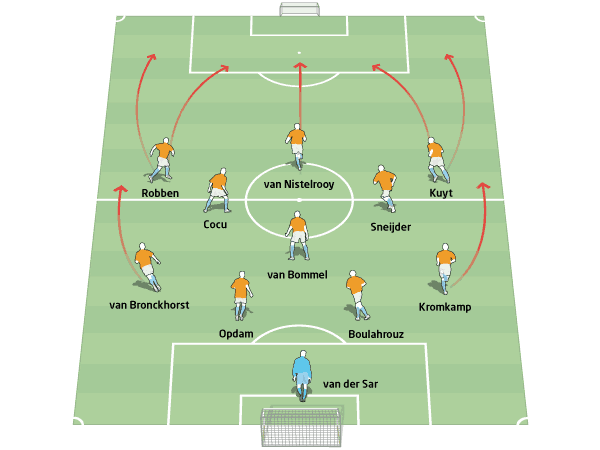 |
|
|
|
WING PLAY |
|
| The Dutch use real wingers — rare in international soccer. In this 4-3-3 system,
you've got these wide players who operate on the outside. Skip to next paragraph World Cup
Playbooks Italy: The Lockdown Brazil: All-Out Attack Germany: The Free Kick England:
Midfield Power U.S.A.: Going Wide One-on-One The New York Times Sports Magazine. Go to
Complete Coverage » Arjen Robben and Dirk Kuyt are two guys on the wing, and they love to
go right at you one-on-one. Robben especially has the ability to cut inside and get shots
off. Or he can beat you to the outside and serve crosses into the box in front of the net.
Their target man is Ruud van Nistelrooy. He's amazing in the box, a guy who gets so many
goals from within six yards of the net. And he's going to get tremendous service from his
teammates on the flanks. That's the thing about the Dutch: every player — defenders,
midfielders, forwards — has a high level of competence on the ball. There's a
historical memory of Total Football here: the great Dutch system of the mid-70's that
revolutionized the game, where players would change positions on the fly. I wouldn't call
the setup of this team complete Total Football, but they have the personnel to come close.
|
|
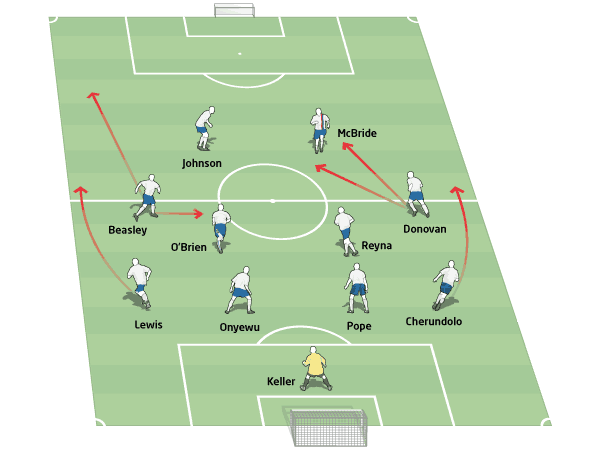 |
|
|
|
GOING WIDE |
|
| The Americans like to play a 4-4-2 and go through the midfield with short passes from
player to player, not over the midfield with long balls directly from the defense to the
forwards. It's just a bit of the Latin style. Skip to next paragraph World Cup Playbooks
Italy: The Lockdown Brazil: All-Out Attack Germany: The Free Kick England: Midfield Power
The Netherlands: Wing Play One-on-One The New York Times Sports Magazine. Go to Complete
Coverage » They'll have Claudio Reyna and John O'Brien in the middle of the midfield,
anchoring it, and that gives freedom to Landon Donovan and DaMarcus Beasley to go inside
or outside. Then, if they want to open it up a bit, either Reyna or O'Brien will move
forward a little while the other will stay back and help defend. Here, the ability for
them to get around and wide is going to be important. That's where Eddie Lewis and Steve
Cherundolo come in; they're both good servers of the ball. Beasley is also a very good
wide player. These players will get forward and bring the ball into the corners. In the
last World Cup, they made great runs wide against Portugal and Mexico to set up important
goals. That'll be a characteristic this time, too. |
|
AND NOW FOR A LITTLE ONE-ON-ONE |
|
|
|
|
THE FLICK FLACK |
| Players like Ronaldinho and Sweden's Zlatan Ibrahimovic show remarkable ball control
with this move, also known as the elastico. After pushing the ball one way with the
outside of his foot, a player immediately drags it back the other way with the inside.
When it's done at full speed, the ball appears stuck to his foot. |
|
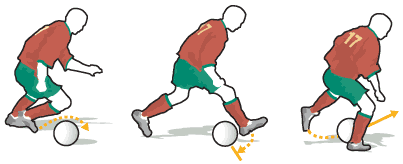
|
|
THE SCISSORS |
| Cristiano Ronaldo, the Portuguese dribbling wizard, likes to feign kicking the ball
with the outside of his foot and instead steps over it, throwing the defender off balance.
He often repeats the move with his other foot: the double scissors. a popular dribbling
move, the scissors is also a favorite of France's zinédine zidane. |
|
 |
|
THE TURN |
| As the Ivory Coast striker Didier Drogba runs, he changes the direction of the ball by
knocking it with the heel of his trailing leg. The move is a variation of one pioneered by
the Dutch legend Johan Cruyff, but Drogba and the Argentine attacker Lionel Messi use this
trick at a full sprint, leaving defenders wrong-footed. |
|
ILLUSTRATIONS By +ISM |
|
|
|
|
|
|
|
|

